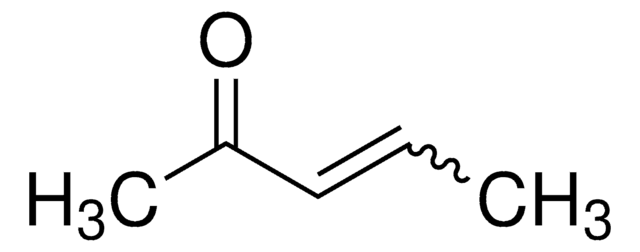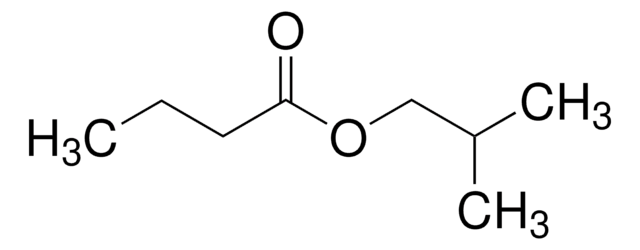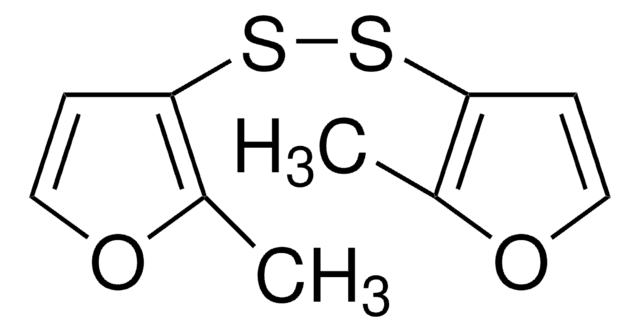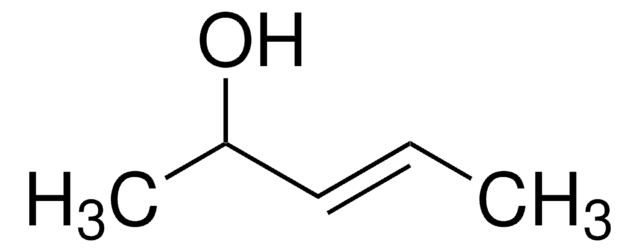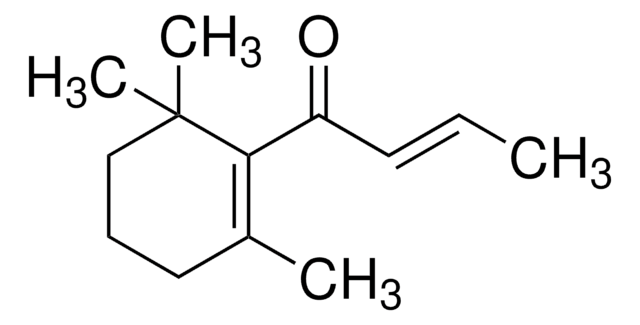Wichtige Dokumente
W335207
4-Hexen-3-one
≥92%
Synonym(e):
4-Hexen-3-on, überwiegend trans-Form
About This Item
Empfohlene Produkte
Biologische Quelle
synthetic
Qualität
Halal
Assay
≥92%
Brechungsindex
n20/D 1.44 (lit.)
bp
135-137 °C (lit.)
Dichte
0.858 g/mL at 25 °C (lit.)
Anwendung(en)
flavors and fragrances
Dokumentation
see Safety & Documentation for available documents
Organoleptisch
pungent; ethereal
SMILES String
CCC(=O)\C=C\C
InChI
1S/C6H10O/c1-3-5-6(7)4-2/h3,5H,4H2,1-2H3/b5-3+
InChIKey
FEWIGMWODIRUJM-HWKANZROSA-N
Suchen Sie nach ähnlichen Produkten? Aufrufen Leitfaden zum Produktvergleich
Allgemeine Beschreibung
Anwendung
- Key lime (Citrus aurantifolia) inhibits the growth of triple drug resistant Helicobacter pylori.: Explores the antibacterial properties of key lime, potentially including volatile components like 4-Hexen-3-one, highlighting its relevance in medical microbiology and the development of alternative therapeutic agents (Lee et al., 2018).
- Chemical composition of hexane extract of Citrus aurantifolia and anti-Mycobacterium tuberculosis activity of some of its constituents.: Investigates the components of Citrus aurantifolia hexane extract, including the role of 4-Hexen-3-one in combating Mycobacterium tuberculosis, demonstrating the potential of natural products in treating infectious diseases (Sandoval-Montemayor et al., 2012).
- Kinetic investigation of the OH radical and Cl atom initiated degradation of unsaturated ketones at atmospheric pressure and 298 K.: This study examines the reactivity of atmospheric ketones including 4-Hexen-3-one with OH radicals and Cl atoms, providing valuable data for understanding their fate in the atmosphere (Blanco et al., 2012).
Haftungsausschluss
Signalwort
Warning
H-Sätze
Gefahreneinstufungen
Acute Tox. 4 Oral - Eye Irrit. 2 - Flam. Liq. 3 - Skin Irrit. 2 - STOT SE 3
Zielorgane
Respiratory system
Lagerklassenschlüssel
3 - Flammable liquids
WGK
WGK 3
Flammpunkt (°F)
93.2 °F - closed cup
Flammpunkt (°C)
34 °C - closed cup
Persönliche Schutzausrüstung
Eyeshields, Faceshields, Gloves, type ABEK (EN14387) respirator filter
Hier finden Sie alle aktuellen Versionen:
Besitzen Sie dieses Produkt bereits?
In der Dokumentenbibliothek finden Sie die Dokumentation zu den Produkten, die Sie kürzlich erworben haben.
Kunden haben sich ebenfalls angesehen
Unser Team von Wissenschaftlern verfügt über Erfahrung in allen Forschungsbereichen einschließlich Life Science, Materialwissenschaften, chemischer Synthese, Chromatographie, Analytik und vielen mehr..
Setzen Sie sich mit dem technischen Dienst in Verbindung.